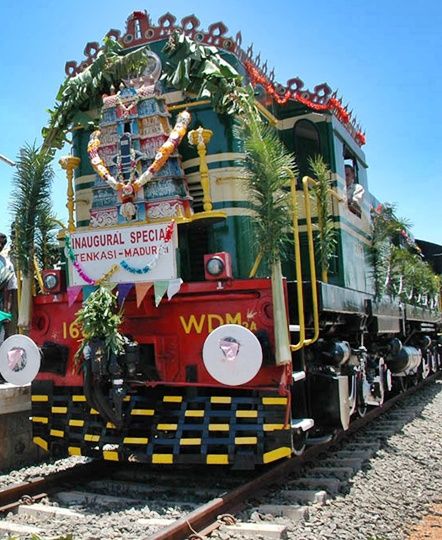 | « Back to article | Print this article |
Union Railway Minister Suresh Prabhu aligns priorities, funding and organisation to shape a transformation agenda, notes Vinayak Chatterjee.
 It is not easy being railway minister. Ask Union Railway Minister Suresh Prabhu.
It is not easy being railway minister. Ask Union Railway Minister Suresh Prabhu.
Everybody in India has a strong opinion on what the Railways should do.
There are tomes of recommendations from weighty committees - notably the Rakesh Mohan Committee on Restructuring, 2002; the Kakodkar Committee on Safety, 2012; the Pitroda Committee on Railway Modernisation, 2012; and finally the Bibek Debroy Committee on Railway Reform, 2015.
Weave in the political imperative to demonstrate visible action to an aspirational India wanting bullet trains, and a bottom-of-the-pyramid India wanting to avoid getting trampled to death on railways stations during festival rushes.
Then there are the railway unions that get into paroxysms of righteous indignation whenever they hear the words privatization and PPP (public-private partnership)and threaten strikes to bring the nation to a halt.
If this were not enough, you have a staid, monolithic Railway Board and related establishments steeped in complacent Raj-era traditions alongside an archaic accounting system which Bibek Debroy publicly decries as being "non-transparent".
And to put matters in perspective, India spends only 0.3 per cent of its gross domestic product on railways as against China's 2.5 per cent. Even investments in highways has risen to 1.5 per cent.
Prabhu took charge of the Railways on November 9, 2015 - no doubt a wise choice by the Prime Minister, and welcomed by all. Ten months into the job, this affable, ego-less, practical and savvy professional-turned-politico is briskly working on his game plan.
So, has he got his priorities right? Does he have the finances to address these priorities? And are the allocations in sync with the priorities?
In a scan of his speeches, press and industry interactions, and other public deliveries, the priorities clearly reveal themselves.
The number one priority is clearly network decongestion and network expansion. Nobody can quarrel with this. Out of 1,219 sections of the Indian Railways, 492, that is 40 per cent of the network, operates at more than 100 per cent capacity. Mughalsarai is reportedly the most congested at 150 per cent.
Compared to the enormity of this problem, everything else pales into insignificance; and adding more rolling stock is akin to passing a thick rope through the eye of a needle.
Next is safety. That is followed by rolling stock modernisation, station redevelopment, passenger amenities, special projects, organisation revamp and social obligations (North-east and Kashmir connectivity). The priorities are clearly bang on target.
Moving on to funding and allocation, the two tables reveal the funding plan and allocations thereof.
For an establishment, struggling to generate internal cash at close to 90 per cent operating ratio; and dependant on the Union Budget for under Rs 50,000 crore, the railway minister has done well to plan to mop up cash from joint ventures (with states, public sector units ports et al), PPPs and debt.
From the institutional debt bucket, Rs 1.5 lakh crore from the Life Insurance Corporation of India is already being put to use for network decongestion, and others like the World Bank, National Infrastructure and Investment Fund, tax-free bonds et al are work-in-process.
The fundraising scenario is grounded in its potential for practical achievability and is certainly not a pie-in-the sky projection.
The allocation of finances is congruent with the priorities. It is commendable that the minister has stayed away from populism and stuck to the urgent requirement of alleviating the rail network congestion.
Close to 45 per cent of all the funding is earmarked for network decongestion, and network expansion.
Does that mean that all challenges and concerns are taken care of? By no means.
Clearly, the biggest elephant in the room is organisational rejuvenation. Here Prabhu appears to be the only minister in the Union Cabinet who openly welcomes the idea of an independent regulator.
Nitin Gadkari trashes the idea of an independent regulator for highways just as Piyush Goyal feels that a regulator for coal is unnecessary.
But Prabhu believes that an independent railway regulator is required for tariff setting, engagement with the private sector and service-level accountability from the railway establishment.
It is understood that he is working behind the scenes to make this a reality in as much as he is personally engaged in track II diplomacy with the unions to get their buy-in for his growth and development vision.
In fact, the top railway union leaders sit in on the Ratan Tata-chaired Kaya Kalp Council. The much-recommended revamp of the top echelons of the 'Railway Diwan-i-Am', is also a challenge.
Its break-up into a governance board with independent directors and an executive board (much like the current Railway Board) are changes up for consideration as are issues of decentralisation and 'SBUisation'.
This great railway transformation has to be achieved in the middle of day-to-day pressures of profitability, winning back passenger confidence and positivism, and arresting the slide in freight carried.
This is clearly the best time for the Railways to effect a long-awaited and historic turnaround under a purposeful prime minister and an indefatigable railway minister.
To achieve this, Prabhu has clearly set out his own challenging set of tasks which we heartily endorse. More importantly, we wish him luck.
The author is the chairman of Feedback Infra.